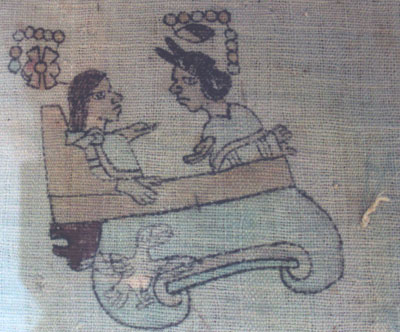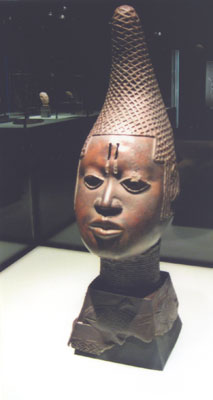Berlin’s Ethnological Museum ‘discovered’
This item appears on page 62 of the July 2012 issue.
There are not many visitors to Berlin who miss seeing the spectacular second-century-BC Pergamon Altar or the equally spectacular sixth-century-BC Babylonian Ishtar Gate, both in the Pergamon Museum in central Berlin. Tourists also invariably pay their respects to the world-famous painted head of Queen Nefertiti, wife of the 18th Dynasty Egyptian pharaoh Akhenaten (1351-1334 BC), in the Neues Museum near the Pergamon.
Certainly, I do, too, on every visit to Berlin. But it was only on my most recent trip in April 2011 that I discovered a fabulous museum unknown to me, located a little out of the mainstream of Berlin’s plethora of world-class museums. It’s the Ethnological Museum in Dahlem, southwest of central Berlin, in a leafy area of private homes and cafés.
The museum comprises distinct collections, including Mesoamerica; the Andes; North American Indians; South Seas and Australia, and Africa. In addition, there’s the Asian Art Museum and the Museum of European Cultures, both occupying the same building.
There are thousands of artifacts on display. The museum claims that only about three percent of its entire collection is on view at any given time. All I can do is mention a highlight from each of the collections and urge readers to see for themselves the riches on display.
Pre-Conquest artifacts
The Mesoamerica Collection is dedicated to the pre-Hispanic cultures of what is now Mexico, Guatemala, Belize, Honduras and El Salvador. Among the immense stelae from Guatemala, the decorated Mayan clay pots and vases and the heavy stone yokes once used in the ritual ball game played throughout Mesoamerica is a unique piece called the Seler Lienzo II.
It’s a piece of cotton cloth, 12 feet by 14 feet, Mixtec (Oaxaca, Mexico) in origin and dating from around AD 1600. On it is portrayed in picture writing the lineage of a noble Mixtec family plus a map of their territory. In effect, it’s a document justifying their claim to the land they occupied.
What makes this piece of cloth even more significant and unique is that it also incorporates scenes from after the Conquest: the execution of an Indian, a Spanish judge and two Spanish priests.
The Andes Collection highlights the pre-Inca and Inca cultures of what is present-day Peru, Ecuador, Bolivia and parts of Argentina and Chile. I wanted to see the Gold Cabinet to compare it with the Gold Museum I had visited in Bogota, Colombia, recently, but it was temporarily closed (it reopened in July 2011). I contented myself with the clay vessels and bowls of the Nazcas, Moches and Chimus of pre-Conquest Peru.
The most unique — and most poignant — artifact was the well-preserved mummy bundle, dating from about AD 1400 to 1500, found in Chuquitanta, Peru.
X-rays show that it contains the body of a six-month-old baby wearing a shell necklace around its neck. The mummy is wrapped in cloth and two cotton tunics, with a cotton purse containing corncobs hanging from a belt. Another tiny purse with a comb made of cactus thorns hangs from the neck of the bundle. A silver mask covers the false “head” of the bundle; the baby was actually tucked within the bundle, itself.
Pacific treasures
The South Seas Collection comprises artifacts from Polynesia, Micronesia, Melanesia and Australia. In addition to the 19th-century Marshall Islands sailboats and the Papua New Guinean masks and woodcarvings, there’s a superb example of a bai, a men’s “clubhouse” from Palau in western Micronesia.
Built in 1907, it incorporates legends and historical events in picture form on both its exterior and on the wood beams inside. The house is covered with a high-pitched thatch roof. Such clubhouses were gathering places for the men of the community.
The Africa Collection has a fantastic set of wood masks and an extraordinary royal throne made in the 19th century of wood, textile, glass and shells for the king of Bamum in Cameroon.
But the highlight, for me, were the Benin bronzes, especially the exquisite 16th-century bronze head of an iyoba, or queen mother. Queen mothers were extremely important in Benin as in other African cultures, exerting a great deal of influence. The beautiful bronze exhibited is an idealized image rather than an actual likeness — unlike the Nefertiti bust, which is probably an actual portrait of the woman.
There’s also a North American Indian Collection, with Hopi kachina dolls, Navajo carpets, walrus-ivory Eskimo carvings and Kwakiutl cedar wood masks.
The Ethnological Museum also houses an Asian Art Museum. I spent so much time visiting the other collections that there was no time to even peek at what lay in this section. I was the last visitor to leave the museum and was ushered out casting longing backward glances at the treasures within.
If you go…
The Ethnological Museum (8 Lansstrasse, Dahlem, Berlin) is open 10 to 6 Tuesday to Friday and 11 to 6 Saturday and Sunday and closed Monday. It’s easy to reach via the U-bahn, Berlin’s underground transportation system. Line U-3 will take you to the Dahlem-Dorf station, a trip of about 30 minutes from central Berlin (Brandenburg Gate area). There’s both a coffee shop and a restaurant on site.
My husband and I spent 16 nights at the Adina Apartment-Hotel (35 Krausenstrasse; phone 49 30 200 7670), in Berlin-Mitte (Berlin Center), close to Gendarmenmarkt (full of cafés and restaurants) and the old Checkpoint Charlie, one of the entry points into post-WWII East Berlin.
The Adina is special. It’s both a hotel and an apartment complex and offers the best of both worlds. Guests have the space and amenities of an apartment (kitchen with dishwasher and microwave, a washer/dryer and, in most of the apartments, separate bedrooms) as well as the amenities of a first-class hotel (on-site bar and restaurant, room service and reception desk).
Our classy, small apartment had a living/dining room with kitchenette, a separate bedroom and a balcony.
There are three Adinas in Berlin as well as others in Frankfurt, Hamburg, Copenhagen and Budapest. There are also 21 properties in Australia marketed under the name “Medina.” The Adina at Checkpoint Charlie was close to much of what we wanted to see, either by walking or by a quick, 10-minute cab ride. The nearest U-bahn station was a 10-minute walk away.
Rates vary, depending on the day of the week, but currently range from €89 (studio) to €279 (2-bedroom apartment) per night, low season, and €107-€349 ($133-$434), high.
For information on Berlin, check www.visitberlin.com.


